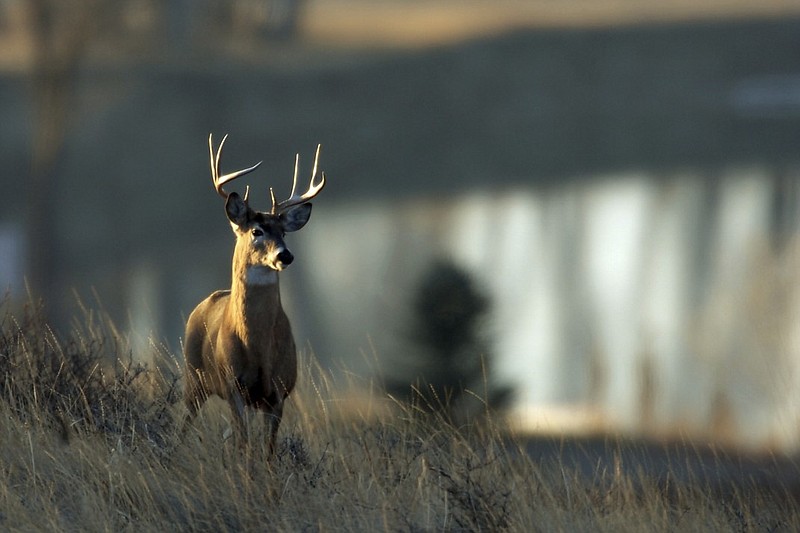For those of you who do not pursue white-tailed deer, here's a news flash.
Many hunters are obsessed with antlers.
I think this has been going on since the first deer hunter took the first buck by means of a throwing a sharp stick. The hunter walked up to his prize, knelt down and grabbed hold of an antler.
The die was cast, the bond was forged. He would spend the rest of his short life looking for more and bigger antlers.
Just so we get our terminology correct here, we may talk about a white-tailed buck having big "horns," but members of the deer family, Cervids, do not have horns - they have antlers. Antlers are a form of modified bone that goes through a well-documented growing cycle. They form with living tissue, harden and eventually drop off, then the cycle starts all over again.
How these antlers grow, how big around they get (antler aficionados refer to this as "mass") and the number of "points", (how many antler tips the buck may grow this year) are all part of the mix that fascinates hunters who chase the big racks.
I do not fully understand all of this. I am not a dyed-in-the-wool big buck hunter. I have not one thing against those who are - I am happy that they are happy in their world. I even like to eat venison. I just don't worry about the antler thing so much. Big gobbler turkeys with long, sharp spurs are another matter. (You go to your church and I'll go to mine.)
But I believe more and more emphasis on taking deer with larger antlers has caused some shakeups in the deer hunting world. There was a time when most deer hunters ventured to the field in the antlered buck season only wanting to take a buck. If a bruiser came by with a 10-point rack, that was great, but if a young spike buck or forked-horn deer showed up, he was probably going home with the hunter (in the bed of the truck).
Times change. These days more and more hunters are concerned with the quality of the antlers they bring home.
I have written about the Quality Deer Management Association before. Since 1988, QDMA has worked to promote sustainable, high-quality deer populations, wildlife habitats and ethical hunting experiences through research, education, advocacy and hunter recruitment. QDMA teaches deer hunters how to improve local deer populations, habitat and hunting experiences.
I believe in QDMA and think they do good things. I recently spoke with Lindsay Thomas Jr., director of communications at QDMA, and he reminded me of some of the basic tenants of this conservation-minded organization.
"To enhance the fun and excitement of deer hunting, QDMA encourages the protection of most or all yearling (1 1/2-year-old) bucks, combined with an appropriate harvest of does when necessary, to maintain a healthy population in balance with habitat conditions and hunter desires," Thomas said. "We also believe hunters who have never killed a buck should be able to choose any buck that makes them a happy hunter, and most QDMA staff members killed a yearling for their first buck."
So if I'm getting it right, QDMA teaches to let all the first-year bucks walk you can. It's no secret these deer are not as wary as older bucks and would be the first to fall when the rifle season starts. QDMA is saying if you protect as many of these deer as you can, the next year several of these deer (now 2 1/2-year-olds) may be killed, but some will survive and will continue to grow and become 3- and 4-year-old deer and on up.
And then you'll start seeing more quality bucks in your area. Thomas pointed out some advantages of having a socially and nutritionally balanced deer population that I would not have thought about. Hunters may witness the full range of social behaviors. "Bachelor groups" of bucks can be observed in summer. Rubs and scrapes are more common in the woods. Hunters witness more buck fights, see more bucks chasing does and more often hear vocalizations like grunting.
Calling techniques like rattling are more productive. Overall, the rut (breeding season) is more apparent and intense, leading to a more enjoyable hunting experience and better hunting success. Other benefits include dramatically increased success at finding shed antlers, which also leads to greater knowledge of travel corridors, bedding areas and feeding habits.
If you are a serious deer hunter, you need to look into QDMA. (Check out qdma.com to learn more.)
I'm not a rocket scientist when it comes to deer management, but I think the basic premise is pretty simple. If you want bigger bucks around, let most of the little guys walk.
Just don't judge me if I partake in some of the bounty of doe season. I'll be the guy in the party who just wants to take home some tenderloin.
"The Trail Less Traveled" is written by Larry Case, who lives in Fayette County, W.Va. You can write to him at larryocase3@gmail.com.
